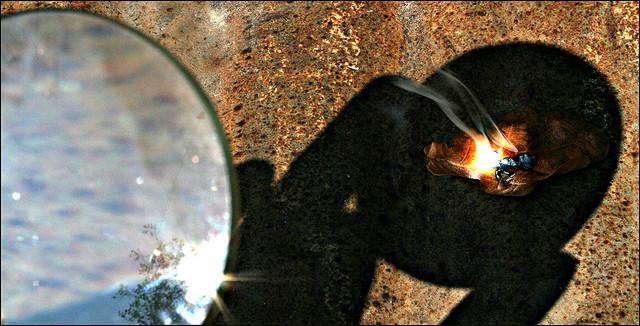
The beta.ray
by Keith D. Foote
Concentrator photo-voltaics (CPV) describes a system generating electricity from sunlight. Differing from conventional photo-voltaic systems, it uses lenses and curved mirrors to focus sunlight onto small, but very efficient, multi-junction (MJ) solar cells. Additionally, these systems often use solar trackers, and sometimes a cooling system, to further increase their efficiency. Ongoing research and development is rapidly improving their effectiveness.

Source Dave Gough via Flickr.com
CPV systems using ?high? concentrator photovoltaics (HCPV) are beginning to become efficient enough to compete with the electrical grid. They currently have the highest efficiency of all existing PV technologies, and having a smaller photo-voltaic array also reduces production costs. Currently, CPV is far less common than conventional photo-voltaic systems.
In 2013, CPV installations nade up only 0.1 percent, or 50 megawatts, of the annual global photo-volatic market of nearly 39,000 megawatts. However, by the end of 2014, this number had increased to 330 MW, or roughly 0.62 percent. Commercial HCPV systems have reached efficiencies of up to 42 percent and the International Energy Agency sees the potential to increase this efficiency by up to 50% by the mid-2020s.
HCPV competes with concentrated solar power (CSP). Both technologies are best-suited for areas with with lots of sunlight, or, more specifically, the Sun Belt region in the United States and the Golden Banana in Southern Europe. CPV and CSP are often confused with one another, despite being obviously different technologies. CPV uses the photo-voltaic effect to generate electricity from sunlight directly, while CSP, often called concentrated solar thermal, uses light from the sun to make steam for driving a turbine, which then produces electricity using a generator. Currently, CSP is more common than CPV, especially in Spain and the United States, where concentrated solar thermal contributes a significant part on the overall electricity generation from solar power.
A company named Rawlemon has been able to concentrate diffuse light using their Spherical Sunpower Generator, also called beta.ray. From an economical point of view, this is a unique opportunity to produce solar energy where conventional systems fail.
Developed as a stand-alone power charging station, the Spherical Sunpower Generator uses a ball lens and specific geometry to improve energy efficiency by twice as much, compared to existing photo-voltaic panels. Through a combination symmetry and geometry, the transparent spherical globe acts as a concentrator lens and emitter. The unique dual axis tracking system can be fully incorporated into any building surface, improving efficiency and offering up to 99 percent transparency. This allows for deep building integration, particularly for buildings with lacking interior wall, or with glass walls.
In contrast to other types of photo-voltaic ?dual-axis? generators, the beta.ray uses a fully rotational, weatherproof optical tracking device. This allows it to operate on inclined surfaces and nonsupporting walls, making it applicable in a variety of building situations. This new concept also has the ability to concentrate diffused daylight, or even moonlight, for a more effective application. On cloudy days, the device produces four times more energy than a conventional PV system.
The beta.ray can connect to both standard and hybrid collectors in order to convert light and/or thermal energy into electricity.
The beta.ray's use of multi-junction cells helps to demonstrate the great potential of this solar device. Multi-junction cells are designed for concentrator systems. By using a high efficiency multi-junction cell, Rawlemon has succeeded in reducing the cell surface down to 1 percent, as compared to the same power output of a conventional silicon cell in optimal conditions. In combination with the dual axis tracking system, their device is capable of generating twice the yield of a conventional panel. In addition, the beta.ray?s smaller cell area has a lower carbon footprint, because its production requires fewer precious semiconductors.
There are a number of applications the beta.ray can be used for, such as electric car charging stations, energy producing windows, autonomous power generators. India is considered a prime market for solar hybrid power plants using Rawlemon technologies.
?The Future is not Green, it is Transparent? is is the motto of Rawlemon. The design is the brainchild of German Architect, Andre Broessel, who believes his solution can ?squeeze more juice out of the sun?, even during the night hours. His invention could pave the way for efficient solar conversion in low-light areas.
Conventional photo-voltaic panels have to face the sun?s rays at a 90� angle for maximum efficiency. Consequently, stationary solar panels have an inefficient solar conversion. The size and cost of traditional photo-voltaic panels are high, and sensitive to the impact of weather. The beta.ray uses its simple spherical geometry to create an optical phenomenon. It concentrates the diffused light from the sun through a ball lens to a collector which contains the solar panels.
The Rawlemon Spherical Sunpower Generator is about to make a huge impact on the renewable energy world. In the most basic sense, the Spherical Sunpower Generator is very much like starting a campfire with a magnifying glass. Designed by the German architect, Andr� Broessel, it was selected as a finalist in the 2013 World Technology Awards. Solar panel technology has been evolving for more than 40 years, but it?s not nearly as effective as this new design for harnessing power from the sun. For example, unless the sun is tracked via precision motors, today?s most efficient solar panels can be 70% less efficient than the Rawlemon Spherical Solar Generators in their prime. Also, the Spherical Solar Generators produced by the Rawlemon company has drastically reduced the overall size of given solar ?panel.? Soon, these spherical generators may replace the need for vast stretches of open fields for large numbers of solar panels.
Curiously (or not), one of the biggest complaints comes from the anti-solar panel portion of the population (a small group) who describe it as a ?gruesome eyesore.? Some people simply don't like the high-tech look of solar panel technology.